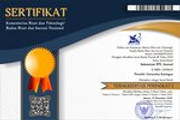STUDENTS' PERSPECTIVES OF ONLINE LANGUAGE LEARNING DURING CORONA PANDEMIC: BENEFITS AND CHALLENGES
Abstract
This study aimed to elicit students' perspectives towards benefits and challenges of fully online classes at Hebron University. The researchers examined both advantages and challenges of online classes from students' point of view. Also, they explored some suggestions for improving online classes which could play an important role in improving the online learning and teaching process. The researchers employed quantitative methods. They distributed a questionnaire to collect data. Eighty two students from two different English intensive courses were asked to fill a 5 point Likert scale questionnaire and answer four open-ended questions. The researchers used the survey planet app to facilitate the process of distributing and collecting data. The finding of this study showed that students faced some challenges with online learning; they preferred face to face classes. The disadvantages of online classes from their perspectives are more than the advantages. The weak internet connectivity, poor interaction, less motivation, less participation and less understanding are the most challenges of online learning. However, they find online classes easy to access, convenient and easy to be reviewed for exams.
Keywords: Online learning; advantages; challenges
Full Text:
PDFReferences
Adnan, M. Anwar, K. (2020). Online learning amid the COVID-19 pandemic: Students perspectives. Journal of Pedagogical Research. 1(2):45-51. http://doi.org/10.33902/JPSP.2020261309
Aminullah, A., Loeneto, B. A., & Vianty, M. (2019). Teachers’ attitudes and problems of using ICT in teaching EFL. English Review: Journal of English Education, 8(1), 147-156. doi: 10.25134/erjee.v8i1.2324.
Arkorful,V. & Abaidoo, N. (2014). The role of e-learning, the advantages and disadvantages of its adoption in Higher Education. International Journal of Education and Research. 2(12), 397-410. https://www.ijern.com/journal/2014/December-2014/34.pdf
Arroyo, M. Berrocoso, J. Cevallos, M. & Videla, C. (2020). Trends in educational research about e-Learning: A systematic literature review. Sustainability. 12(12), 1-23. https://doi.org/10.3390/su12125153
Baber, H. (2020). Determinants of students’ perceived learning outcome and satisfaction in online learning during the pandemic of COVID-19. Journal of Education and e-Learning Research. 7(3), 285-292. https://papers.ssrn.com/sol3/papers.cfm?abstract_id=3679489
Baker, C. (2010). The impact of instructor immediacy and presence for online student Affective learning, cognition, and motivation. Journal of Educators Online. 7(1), https://doi.org/10.9743/JEO.2010.1.2
Beatty, K. (2003). Teaching and researching computer-assisted language learning. New York: Longman.
Brewer, E. & Stout, V. (2001). Moving to Online: Making the transition from traditional instructions and communication strategies. Corwin Press, Inc. CA.
Dahwan, S. (2020). Online learning: A Panacea in the time of COVID-19 crisis. Saga Journals. 49(1), 5-22. https://doi.org/10.1177/0047239520934018
Farrah, M. & Al-Bakry, G. H. (2020). Online learning for EFL students in Palestinian universities during corona pandemic: Advantages, challenges and solutions. Indonesian Journal of Learning and Instruction, 3(2), 65-78. DOI: https://doi.org/10.25134/ijli.v3i2.3677
Fedynich, L. (2014). Teaching beyond the classroom walls: The pros and cons of cyber learning. Journal of Instructional Pedagogies. 13(1). https://www.aabri.com/manuscripts/131701.pdf.
Hsboula, H. (2009). E-learning adoption: The role of relative advantages, trialability and academic specialization. Campus-Wide Information Systems. 26(1):54-70 https://doi.org10.1108/10650740910921564
Roberts, R. & Pennington, B. F. (1996). An interactive framework for examining prefrontal cognitive processes. Developmental Neuropsychology, 12(1), 105–126. https://doi.org/10.1080/87565649609540642
Singh, H. (2003). Building effective blended learning programs. Educational Technology, 43(6), 51-54. http://asianvu.com/digital-library/elearning/blended-learning-by_Singh.pdf
Singh, V., Thurman, A. (2019). How many ways can we define online learning? A systematic literature review of definitions of online learning (1988-2018). American Journal of Distance Education, 33(4), 289–306. https://doi.org/10.1080/08923647.2019.1663082
Richard, H., & Haya, A. (2009). Examining student decision to adopt web 2.0 technologies: theory and empirical tests. Journal of computing in higher education, 21(3), 183-198. https://doi.org/10.1007/s12528-009-9023-6
Oblinger, D. G., & Hawkins, B. L. (2005). The myth about E-learning. British Journal of Educational Technology. 41(2), 199 – 212. https://doi.org/ 10.1111/j.1467-8535.2008.00910.x
DOI: https://doi.org/10.25134/ieflj.v7i1.3986
Refbacks
- There are currently no refbacks.

This work is licensed under a Creative Commons Attribution-ShareAlike 4.0 International License.

